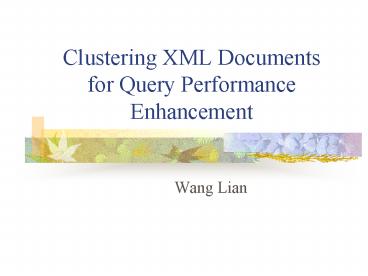Clustering XML Documents for Query Performance Enhancement PowerPoint PPT Presentation
1 / 22
Title: Clustering XML Documents for Query Performance Enhancement
1
Clustering XML Documentsfor Query Performance
Enhancement
- Wang Lian
2
Outline
- Related Work
- Motivation
- Our Approach
- S-Graph
- Distance Function
- Clustering Algorithm
- Experimental Results
3
Related Work
- Besides storing XML documents in their native
format, using RDBMS is an established trend. - There are mainly two approaches for storing XML
documents in RDBMS - Schema-mapping
- Structure-mapping
4
Related Work(cont)
- In Schema-mapping
- A database schema is derived from the DTD of XML
documents, therefore different DTD will generate
different database schema - In Structure mapping
- The database schema is fixed by defining a set of
generic tables.
5
Motivation
- Using both schema or structure mapping, documents
must be cut into pieces and inserted into tables.
To answer a query tables should be joined to
provide the answers. - As the size of tables grows larger, the join cost
may be very high. - Our observation is if a collection contains
documents of different structures, then
clustering on documents structures may reduce
the join cost.
6
Motivation(cont)
- An example
- DTD is
7
Motivation(cont)
- Documents in 3 clusters
8
Motivation(cont)
- Unpartitioned schema
9
Motivation(cont)
- Partitioned schema
10
Motivation(cont)
- Suppose we want to answer an Xpath query
/conference/author.text() - Using unpartitioned schema, table conference (2
tuples )and author (9 tuples) should be joined, - Using partitioned schema, table conference1 (2
tuples ) and author1 (3 tuples) should be joined.
11
Our Approach
- XML document is a mixture of structure
information and data value. In our context, only
structure information is used to do clustering. - We need a proper distance function before using
any clustering algorithm.
12
S-Graph
- Given a set of XML documents C, the structure
graph (s-graph) of C, sg(C) (N, E), is a
directed graph such that N is the set of all the
elements and attributes in the documents in C and
(a, b)?E if and only if a is a parent element of
b in document(s) in C (b can be element or
attribute). - Certainly, s-graph does not catch all structure
information of documents, however it captures the
parent-child relationship which is valuable for
evaluating path expression.
13
Distance Function
- For two sets, C1 and C2, of XML documents, the
distance between them, - where sg(Ci) is the number of edges in
sg(Ci), i1,2, and sg(C1)? sg(C2) is the set of
common edges of sg(C1) and sg(C2).
14
Distance Function(cont)
Dist(doc1,doc2)1 and Dist(doc2,doc3)0.25
Tree-dist(doc1,doc2) Tree-dist(doc2,doc3
)1
15
Clustering Algorithm
- Input X the set of XML documents
- Input k the number of clusters specified by user
- SGpre-clustering(X)
- While(remaining cluster numbergtk)
- Merge cluster Ci and Cj which maximize a
predefined goodness function
16
Clustering Algorithm(cont)
- Complexity
- n X, mSG,
- Time complexity
- The upper bound of pre-clustering is O(nm), in
general, it can be reduced to O(n). - Iterative merging O(m2logm)
- Space complexity
- O(m2)
17
Experimental Results
- The clustering algorithm is tested on real data,
the DBLP XML records, which contains about
200,000 documents composed by 36 elements. - Pre-clustering is effective, after scan 200,000
documents, only 233 distinguished s-graphes
remain, which makes following clustering using
only less than 2 second.
18
Experimental Results(cont)
- After setting the number of cluster to be 3, we
get three clusters containing about 193,000
documents, one for article, and the other two for
inproceedings. - The interesting thing is in those two clusters of
inproceedings, one s-graph is a subgraph of
another.
19
Experimental Results(cont)
- We use Oracle 8.1.5 to store all the documents in
4 versions - Version 1 unpartitioned schema-mapping
- Version 2 partitioned schema-mapping
- Version 3 unpartitioned structure mapping
- Version 4 partitioned structure mapping
20
Experimental Results
- Query type
- Q1 /A1/A2//Ak all possible absolute XPathes
in the documents. - Q2 /A1/A2//Aktext()value''/text()
- absolute XPaths in which Ai, i1,,k, are
randomly - picked and "value" is the value of Ak in some
documents. - Q3 /A1/A2//Akcontains(.,substring'')/text()
- same as Q2 except that the condition tested is
Ak contains a substring
21
Experimental Results
22
Question?

